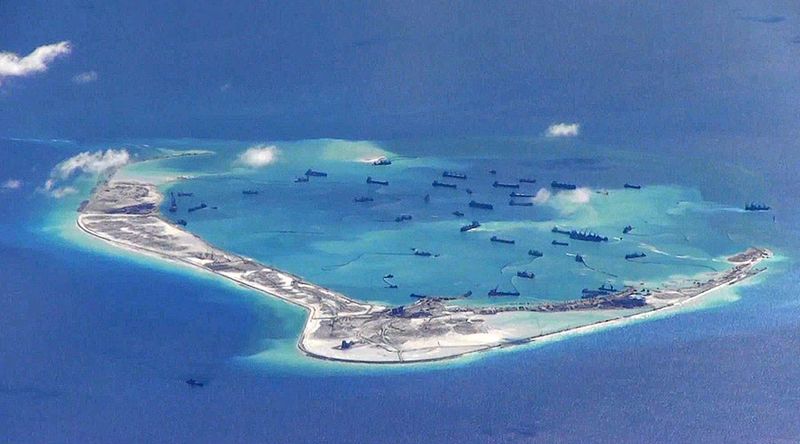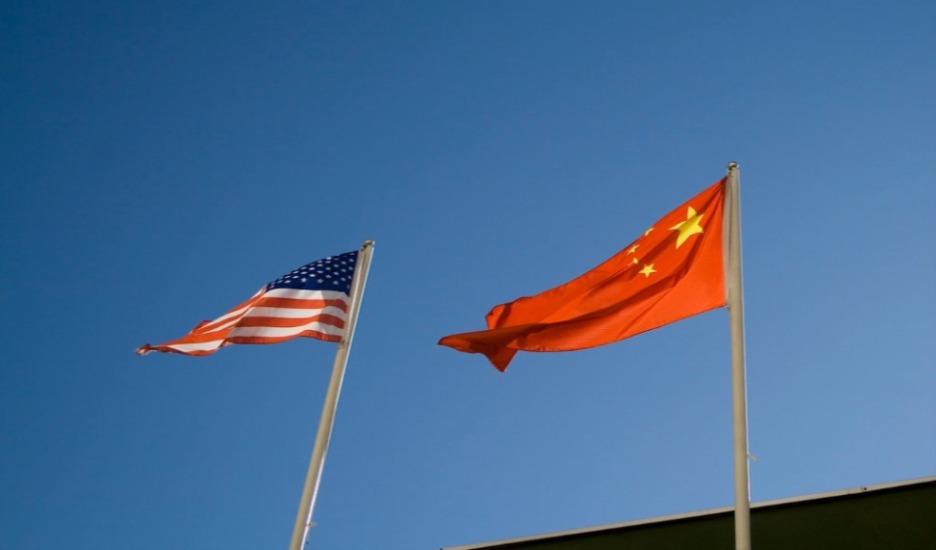Countering China’s Actions in the South China Sea
For many who follow developments in the South China Sea, the July 2016 tribunal ruling in the Philippines’ case against China has become the equivalent of the birth of Jesus in the Gregorian calendar: Developments are considered B.A. and A.A.—Before Award and After Award.
In the first year after the award, compliance was fair: Beijing largely kept its actions, if not its words, within the letter of the ruling.

Published by The Lawfare Institute
in Cooperation With

For many who follow developments in the South China Sea, the July 2016 tribunal ruling in the Philippines’ case against China has become the equivalent of the birth of Jesus in the Gregorian calendar: Developments are considered B.A. and A.A.—Before Award and After Award.
In the first year after the award, compliance was fair: Beijing largely kept its actions, if not its words, within the letter of the ruling.
In late July 2017, however, things went south. The Chinese government insists that the situation in the South China Sea is “calm” and that the region is “in harmony”; it accuses the United States of stirring up trouble. But any stability in the past year has largely been the result of smaller countries in the region resigning themselves to the notion that the weak suffer what they must.
Two years on from the ruling, the stakes are clear: The challenge immediately after the award was getting smaller countries on China’s periphery to be less risk-averse in openly supporting the rule of law; now, the test has become whether the United States and its allies can help countries stand firm against incursions into their exclusive economic zones and defend a rules-based order.
Exclusive Economic Zone Encroachments
The main significance of the 2016 ruling was to clarify resource rights. An international tribunal in The Hague ruled that China cannot claim historic rights to resources in the waters within a “nine-dash line” encompassing much of the South China Sea if these waters are within the exclusive economic zone, or EEZ, of other coastal states. Such rights, the tribunal determined, were extinguished when China ratified the United Nations Convention on the Law of the Sea (UNCLOS) in 1996.
The tribunal also clarified that none of the features in the Spratly Islands—a group of features in the south of the South China Sea that China and five other actors claim—generates an exclusive economic zone that China can claim overlaps with the exclusive economic zones of coastal states. Taken together, the findings make clear that coastal states in the South China Sea are entitled to full 200-nautical-mile exclusive economic zones unencumbered by any Chinese claims.
Although the award is not technically binding except between the parties to proceedings, namely, the Philippines and China, it was clear on China’s maritime entitlements. Beijing should adhere to its findings.
Instead, shortly after the one-year anniversary of the award, Beijing reportedly threatened Vietnam with military action if Vietnam did not stop drilling in its own exclusive economic zone. Prompted by concerns that Washington did not have its back, Hanoi stopped its operations. The Association of Southeast Asian Nations and the rest of the international community averted their gaze. This might well come to be regarded as the point when a rules-based order began unraveling in the region. In March and May this year, Vietnam again attempted to drill for oil and gas in its exclusive economic zone, and Beijing issued similar warnings.
Vietnam is not the only country Beijing has leaned on. Brunei, Malaysia and the Philippines have all come under pressure to concede “joint development” in their exclusive economic zones, a term that has come to suggest legitimate overlapping claims: Where there are such claims, the U.N. Convention on the Law of the Sea stipulates that parties should seek to enter into “provisional arrangements of a practical nature” prior to delimitation of the exclusive economic zone or continental shelf.
Fortresses in the Sea
In recent months, Beijing’s militarization of the South China Sea has escalated. In April, it deployed anti-ship cruise missiles, surface-to-air missiles and electronic jammers to Fiery Cross Reef, Subi Reef and Mischief Reef in the Spratlys. In May, it landed long-range bombers on Woody Island in the Paracels, features to the west of the South China Sea.
The tribunal did not directly address the question of whether the militarization of features was lawful. It considered only whether Beijing’s island-building activities in the South China Sea were military in nature to determine whether it had jurisdiction to rule on these activities. Under the U.N. Convention on the Law of the Sea, when a state signs, ratifies or accedes to the convention, it may declare that it does not accept compulsory procedures entailing binding decisions in certain categories of disputes, including military activities. China availed itself of this option in 2006. The tribunal determined that for ascertaining whether the exclusion applied to deny it jurisdiction, it would take Beijing’s word when it insisted that activities were not military in nature.
Still, China’s activities on features in the South China Sea are problematic. Beijing maintains that it is entitled to do as it wishes on its territory and that this is allowed by international law.
But Mischief Reef is not China’s territory. While the tribunal did not have jurisdiction to rule on competing claims to sovereignty, it did have jurisdiction to determine whether a feature is, at first instance, entitled to an independent sovereignty claim. The tribunal made clear that jurisdiction over a low-tide elevation lies with the country in whose territorial sea or exclusive economic zone it is located. Because Mischief Reef is a low-tide elevation in the Philippines’ exclusive economic zone, the Philippines has jurisdiction over it.
As for the rest of the features in the South China Sea, sovereignty continues to be fiercely contested. International law on the responsibility of an occupying state in a disputed area is far from clear, so Beijing’s actions are, at best, in a legal grey zone.
Lawfare
While Beijing’s dramatic military buildup in the South China Sea has received much attention, its attempts to undermine the tribunal’s award through “lawfare” have been largely overlooked. In the long run, this could shape the narrative on the South China Sea and promote Beijing’s ability to justify its claims and actions.
In mid-May, the Chinese Society of International Law published a “Critical Study” on the South China Sea arbitration case. Over nearly 750 pages, it detailed why it thought the tribunal erred. It was mostly an unremarkable rehash of arguments long raised by Beijing.
Notably, however, the study also attempted to advance an argument that China’s Ministry of Foreign Affairs first laid the foundation for in a statement issued just after the award. The statement’s wording was vague, but it flagged that China was seeking to claim maritime zones from groups of features in the South China Sea rather than from individual features. In other words, Beijing appears to be making the case that even if not entitled to historic rights within the nine-dash line, it was entitled to resources in a wide expanse of sea on the basis of an exclusive economic zone generated from outlying archipelagos.
But under the U.N. Convention on the Law of the Sea, only archipelagic states (such as the Philippines and Indonesia) may draw straight archipelagic baselines from which maritime zones may be generated. The tribunal explicitly found that there was “no evidence” that any deviations from this rule have amounted to the formation of a new rule of customary international law.
China’s arguments are unlikely to convince lawyers, but that is not their intended audience. Rather, their target is the political and business elites in Southeast Asia who are already predisposed to accept Beijing’s claims in the South China Sea. They fear Beijing’s threat of coercive economic measures and eye promises of development through offerings such as the Belt and Road Initiative.
China is also seeking to shape international law to its liking through the strategic use of research funding and has prioritized issues of national import, including the law of the sea.
Holding Beijing Accountable
In April, Adm. Phil Davidson, then commander-designate of U.S. Pacific Command, testified at a Senate Armed Services Committee hearing that China has attained peace-time control of the South China Sea.
At present, such control is not complete: The United States continues to assert maritime rights in the South China Sea and, in a positive development, other maritime powers—Australia, France and the United Kingdom—have also asserted such rights. These operations send the important message that countries apart from the United States care about maintaining an open South China Sea and that rules matter.
However, the Trump administration’s failure to express support for Vietnam or to condemn China’s threats suggests that while smaller countries on China’s periphery are expected to support maritime powers’ defense of navigation, overflight and other freedoms of the seas, the United States and others are quite willing to hang these countries out to dry when it comes to defending their economic rights—a matter that directly impacts their interests. It also feeds into the narrative that support for the United States’ “America First” agenda is effectively a one-way street: all for one and one for none. As countries make their strategic calculations, this will hurt U.S. interests.
Holding Beijing accountable requires action. A comparison of Beijing’s behavior in the first and second year after the tribunal ruling suggests that it responds to coordinated pressure to abide by the rule of law and, conversely, takes advantage of times when the world looks away. As a major power, the United States must organize a regional and international effort to insist that Beijing abide by international law. What should this entail?
First, coastal states must be supported in standing up to any incursions into their exclusive economic zones, including through legal action initiated by coastal states. Second, there must be renewed calls to abide by the tribunal’s ruling. Washington went quiet on this partly because of Manila’s own reticence but also because of the ruling’s implications for U.S. claims to EEZs from small, uninhabited features in the Pacific. The United States should not miss out on the opportunity to demonstrate consistency in supporting the rule of law both within and outside of the South China Sea.
In this vein, the United States should finally accede to UNCLOS. The United States has already committed itself to abiding by the convention; acceding to it, as Adm. Davidson points out, “would give the United States greater credibility when calling on other states to adhere to the same rules.” Many observers note the double standard when the United States calls on other states to abide by the U.N. Convention on the Law of the Sea and comply with decisions of courts and tribunals regarding its interpretation when the United States itself has not acceded to the convention.
Fourth, Beijing’s claims that it is entitled to do as it likes on its own territory should be challenged. This involves reiterating that Mischief Reef is not Chinese. It also involves giving greater consideration to the responsibilities of an occupying state on disputed territories. Beijing should keep its behavior in check on features it occupies but that are also claimed by other parties.
Finally, a successful South China Sea policy must be part of a well-conceived and implemented Asia policy. Regional countries consider wider strategic developments in determining how best to respond in the South China Sea. The United States must continue to demonstrate a clear commitment to the region if it is to effectively counter growing sentiments that China is an unstoppable force and that caving in to Chinese demands now avoids greater pain later. In particular, the Trump administration’s Indo-Pacific strategy will need a strong economic component to provide viable alternatives to China’s ambitious Belt and Road Initiative.
At the International Institute for Strategic Studies’s Shangri-La Dialogue meeting of defense officials in Singapore in June, Defense Secretary James Mattis was sensitive to the region’s need for greater investment, including in infrastructure. But it is unclear whether “private sector-led economic development” will be sufficient. Other possibilities include a coordinated infrastructure fund that the United States and its allies could contribute to. A compelling vision must accompany any such fund: Japan outspends China in infrastructure investment in Southeast Asia, but this goes largely unnoticed.
Beijing is adept at using all instruments, including the law, to reinforce its claims. The United States and other like-minded partners must learn to do likewise if they are to have any hope of turning the tide in the South China Sea. The question for the Trump administration is less one of capacity, or even means, than one of will and focus.


.jpg?sfvrsn=5a43131e_9)


